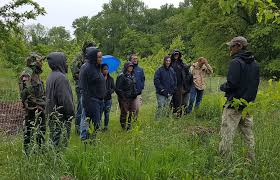The Benefits of Taking a Permaculture Design Course
Permaculture is a sustainable design system that integrates ecological principles, organic gardening, and community building to create harmonious and productive landscapes. If you are passionate about sustainability, food security, and regenerative agriculture, taking a permaculture design course can be a transformative experience.
Here are some key benefits of enrolling in a permaculture design course:
- Learn Sustainable Practices: Permaculture design courses teach you how to work with nature to create self-sustaining systems that benefit the environment and the community. You will learn about organic gardening, water conservation, renewable energy, and other sustainable practices that can be applied in your own backyard or on a larger scale.
- Design Resilient Landscapes: By studying permaculture design principles, you will gain the knowledge and skills to create resilient landscapes that can withstand environmental challenges such as climate change, droughts, and pests. You will learn how to design diverse ecosystems that support biodiversity and enhance ecosystem services.
- Connect with Like-Minded Individuals: Permaculture design courses provide an opportunity to connect with a community of like-minded individuals who share your passion for sustainability and regenerative practices. You will have the chance to collaborate on projects, exchange ideas, and build lasting relationships with fellow permaculturists.
- Cultivate Practical Skills: Permaculture design courses combine theoretical knowledge with hands-on experience, allowing you to develop practical skills in garden design, soil health management, plant propagation, and more. These skills are valuable not only for creating sustainable landscapes but also for enhancing your self-sufficiency and resilience.
Whether you are an aspiring gardener, farmer, designer, or environmental activist, enrolling in a permaculture design course can empower you to make positive changes in your life and community. Embrace the principles of permaculture and embark on a journey towards creating a more sustainable and regenerative world.
Unlocking the Green Thumb: Your Guide to Permaculture Design Certification and Education
- What is a permaculture certification?
- Is a permaculture design certificate worth it?
- How to learn permaculture design?
- Is there a degree in permaculture?
What is a permaculture certification?
A permaculture certification is a credential that validates the completion of a permaculture design course or program. This certification signifies that an individual has successfully acquired the knowledge and skills necessary to apply permaculture principles in designing sustainable and regenerative systems. Permaculture certifications are often obtained after completing a comprehensive course that covers topics such as ecological design, organic gardening, water management, soil health, and community resilience. With a permaculture certification, individuals demonstrate their commitment to environmental stewardship and their ability to create positive change in their surroundings through sustainable practices.
Is a permaculture design certificate worth it?
When considering whether a permaculture design certificate is worth it, it’s important to recognize the value it can bring to both personal development and professional opportunities. A permaculture design certificate not only equips individuals with practical skills in sustainable design and ecological principles but also fosters a deeper understanding of regenerative practices that benefit the environment and communities. Beyond the knowledge gained, a permaculture design certificate can open doors to networking opportunities, collaboration with like-minded individuals, and potential career paths in fields related to agriculture, landscaping, urban planning, and environmental sustainability. Ultimately, investing in a permaculture design certificate can be a rewarding experience that empowers individuals to make meaningful contributions towards creating a more resilient and harmonious world.
How to learn permaculture design?
To learn permaculture design, individuals can explore a variety of avenues that cater to different learning styles and preferences. One common approach is to enroll in a formal permaculture design course, which provides a structured curriculum taught by experienced instructors. These courses cover fundamental principles, design techniques, and hands-on applications of permaculture in various contexts. Additionally, aspiring permaculturists can attend workshops, seminars, or webinars to deepen their understanding and practical skills. Engaging with online resources such as books, articles, videos, and online forums can also supplement one’s knowledge of permaculture design. Furthermore, seeking mentorship from established permaculture practitioners and participating in community projects offer valuable experiential learning opportunities. By embracing a combination of formal education, self-study, practical experience, and networking within the permaculture community, individuals can effectively cultivate their expertise in permaculture design.
Is there a degree in permaculture?
While there is no specific degree in permaculture, many educational institutions offer courses, workshops, and certifications in permaculture design. These programs provide valuable knowledge and practical skills in sustainable agriculture, ecological design, and community development based on permaculture principles. Students can pursue these courses to deepen their understanding of permaculture practices and integrate them into various fields such as agriculture, landscape design, urban planning, and environmental science. While a formal degree in permaculture may not exist, the knowledge and skills gained from these courses can be applied to create positive change in the world.

